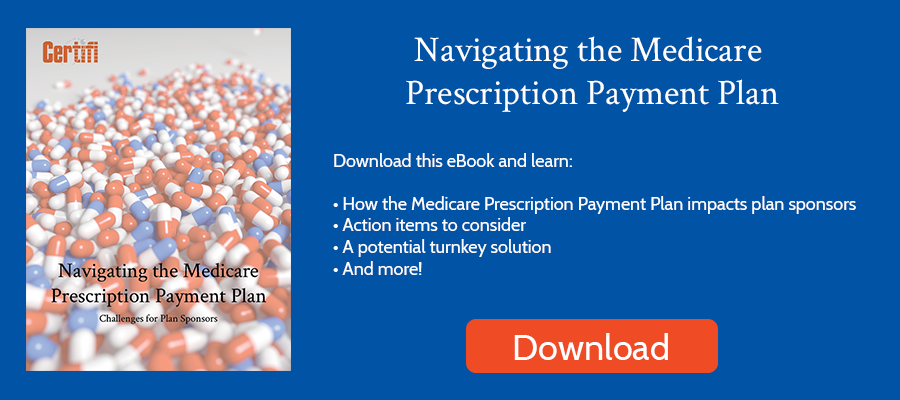Last week, we wrote about the member communication provisions contained in the Medicare Prescription Payment Plan (M3P) Part 2 draft guidance. Part 2 of the M3P draft guidance also provided additional information about pharmacy processes. CMS likely received questions and feedback about non-standard pharmacy situations and aimed to address them in the draft guidance.
For example, plans must notify a pharmacy when an M3P enrollee incurs out-of-pocket costs that would exceed the currently undefined likely-to-benefit threshold and ensure the pharmacy provides a Likely to Benefit Notice when the member picks up the prescription. But what happens if there is additional supplemental coverage, it’s late in the year, or there isn’t direct contact with an enrollee?
In the Part 2 M3P draft guidance, CMS addressed those questions:
Pharmacy Processes for Part D Enrollees with Supplemental Coverage
A few Part D enrollees have supplemental coverage, like a State Pharmaceutical Assistance Program (SPAP). As a result, the final patient out-of-pocket may be lower than the likely-to-benefit notification threshold after those supplemental payments but not before.
As a result, CMS will provide language on the model Likely to Benefit Notice recommending those with supplemental coverage seek advice about their situation before enrolling in the M3P. CMS also advises plan sponsors to inform customer service representatives that they may need to review additional records to determine supplemental coverage.
Pharmacy Point of Sale Notifications Late in the Year
Because of the way CMS designed the first month and subsequent month M3P billing calculations, those who enroll late in the year may not see any benefit from enrolling. They may need to pay the entire prescription cost in the first month if they enroll in the final quarter of the year. As a result, CMS wants plan sponsors to ensure customer service representatives understand how the calculation may impact late-year enrollees.
Pharmacy Point of Sale Notifications in Retail and Non-Retail Pharmacies
As mentioned above, plans must ensure that pharmacies deliver Likely-to-Benefit notices to those above the out-of-pocket threshold. That applies even if the enrollee visits the pharmacy and declines to fill a prescription. CMS also encourages pharmacies to leverage other modes to deliver the Likely to Benefit Notice, for example, through a patient portal or email.
Long-term Care Pharmacies
Long-term care pharmacies typically don’t have direct contact with an enrollee. Instead, they dispense the drug to the long-term care facility. As a result, the plan sponsor can require the long-term care pharmacy to provide the Likely to Benefit Notice during its typical billing process.
They also may not collect cost-sharing directly from the enrollee but may instead bill the long-term care facility. As a result, plan sponsors should work with the participant, their representative, and the long-term care pharmacy to determine the best billing approach.
Indian Health Services (IHS), Tribe and Tribal Organization, and Urban Indian Organization (I/T/U) Pharmacies
Because I/T/U pharmacies provide eligible IHS enrollees with no-cost prescription drugs at I/T/U pharmacies, the pharmacy collects no payment at the point of sale. As a result, Part D sponsors do not need to notify these pharmacies that the enrollee is likely to benefit from the program.
Additionally, if a plan sponsor received an M3P claim from the I/T/U pharmacy for an IHS enrollee, it should reject it because there’s typically no out-of-pocket cost. It should also ensure that customer service representatives know that IHS enrollees who only use I/T/U pharmacies will not benefit from the M3P program.
Other Pharmacy Types
If the pharmacy does not have in-person contact with an enrollee, plan sponsors must have the pharmacy call the enrollee (or contact them by another preferred method) to relay information in the Likely to Benefit Notice.
Readjudicating Claims for New Participants
In some cases, enrollees may arrive at the pharmacy, read the Likely to Benefit Notice and leave without their prescriptions. They’ll sign up for the Medicare Prescription Payment Plan and then return for their prescriptions.
Per CMS, the pharmacy must reverse and reprocess those claims so that the enrollee pays $0 at the pharmacy. However, that only applies to prescriptions the member did not pick up. If the member had multiple prescriptions and decided to take home two prescriptions, signed up for the M3P, and then came back to pick up a third prescription, those two prescriptions the member took home before the enrollee signed up for the M3P, those prescriptions would not be reprocessed.
Bidding Guidance
Because any unsettled M3P balances owed by participants are considered plan losses, CMS plans to modify the Part D bid pricing tool to reflect projected losses from the M3P program. The Part D bid pricing tool will reflect those losses as administrative costs.
Medical Loss Ratio
Unsettled M3P balances also impact the Medical Loss Ratio (MLR) calculation. Because unsettled M3P balances are considered plan losses and administrative costs, they will be removed from the MLR numerator.
Monitoring and Compliance
CMS indicated it will deliver additional guidance regarding PDE reporting as part of new PDE reporting instructions, available in spring 2024. Part One of the M3P draft guidance contains more information about other monitoring and compliance programs.
Audits
CMS noted that it may perform audits of sponsors’ M3P implementation.
Reporting Guidance
Finally, CMS indicated it doesn’t expect any changes to DIR calculations or reporting as a result of the M3P.
Certifi’s Medicare Prescription Payment Plan billing and payment solutions help Part D plan sponsors and PBMs save time and improve M3P billing accuracy.



